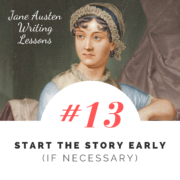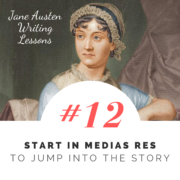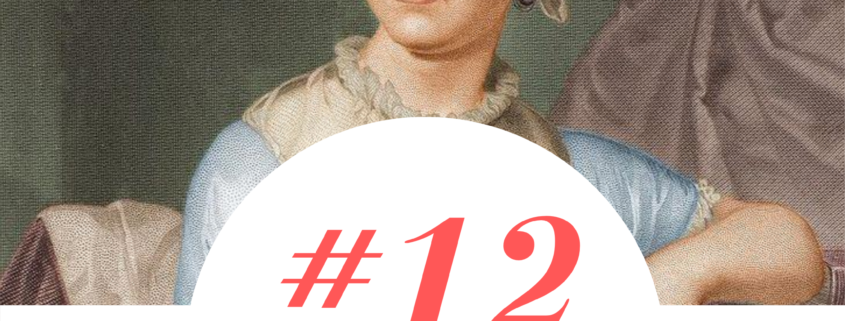Full Sized Blog Element (Big Preview Pic)
#13: Start the Story Early (If Necessary)
/0 Comments/in Jane Austen Writing Lessons/by Katherine Cowley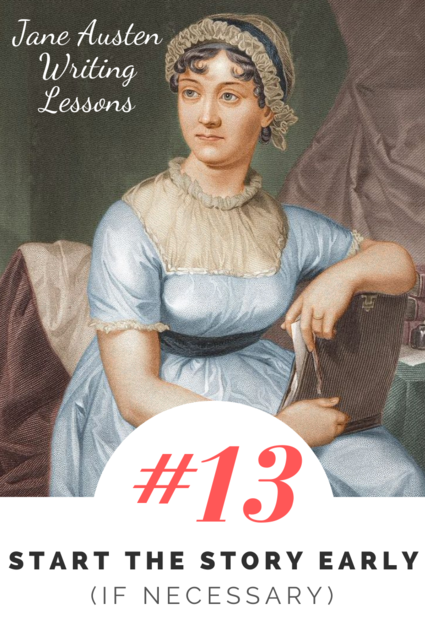
Most stories start not long before the inciting incident, providing a brief description, moment, scene, or a few chapters which encapsulate the period BEFORE—before everything changes for the characters. Emma and Persuasion provide good examples of this.
Other stories, like Pride and Prejudice, start after the inciting incident—in medias res.
Yet other stories take a very different approach to exposition and start long before the inciting incident disrupts the story (note that starting long before the inciting incident does not necessarily mean that the telling of the exposition needs to be long—expositions that start early can still be brief). Jane Austen uses this technique in two of her novels: Northanger Abbey begins at Catherine Morland’s birth, and Mansfield Park begins years before Fanny Price is born.
These two novels start the exposition early for two different purposes:
- Northanger Abbey: To show the main character’s life trajectory, and to contrast the inciting incident (and what comes as a result) against the character’s entire life.
- Manfield Park: To demonstrate a prior formative moment which caused a drastic shift in the main character’s life, and created a new normal, which is then disrupted by the inciting incident.

Life Trajectory in Northanger Abbey
Northanger Abbey demonstrates the main character’s life trajectory prior to the inciting incident. The novel begins with the line:
No one who had ever seen Catherine Morland in her infancy, would have supposed her born to be an heroine.
After this establishment of theme (and the delightful, rather satirical approach of the entire novel), we learn of Fanny’s birth:
Her mother…had three sons before Catherine was born; and instead of dying in bringing the latter to the world, as anybody might expect, she still lived on—lived to have six children more…
We follow Catherine Morland’s childhood, learning that she prefers cricket to dolls, seeing her disinterest in learning and watching her quit music after only a year or instruction. The narrator jumps from Catherine at age ten to age fifteen, and we see her continued development:
To look almost pretty is an acquisition of higher delight to a girl who has been looking plain the first fifteen years o her life, than a beauty from her cradle can ever receive.
Catherine reaches seventeen, with nothing to interrupt the path that she is on, a point that the narrator draws attention to:
She had reached the age of seventeen, without having seen one amiable youth who could call forth her sensibility; without having inspired one real passion, and without having excited even any admiration but what was very moderate and very transient. This was strange indeed!
All this in the first chapter. By creating a life trajectory, it establishes a shared set of reference points with the reader, reference points that help us understand the main character and who she is prior to the inciting incident. These references are essential, because without them, we would be unable to understand Catherine’s choices throughout the novel—her life trajectory informs her naivety, her desire to be liked, her fascination with new people and places, and how she constantly turns to books as an escape.
The last paragraph of the first chapter establishes the inciting incident, which is placed in direct contrast with the main character’s life to this point:
[Mrs. Allen], a good-humoured woman, fond of Miss Morland, and probably aware that if adventures will not befall a young lady in her own village, she must seek them abroad, invited her to go with them.
The other benefit of this approach to exposition is that it allows the narrator to avoid infodumps later—it would be difficult to include all of these details as backstory later in the story without unnaturally piling them on.
The elements included in Northanger Abbey are referred to again and again throughout the story, both directly and indirectly. By journeying with Catherine from her birth to age 17, we are prepared for the much bigger journey she will take throughout the novel.

Prior Formative Moment/Shift in Mansfield Park
While the exposition of Mansfield Park covers a lot of ground, the main purpose is for us to experience a formative moment, a huge shift, in Fanny Price’s early life.
Manfield Park starts before Fanny’s birth, and focuses on the weddings of the prior generation. Three sisters become, respectively, Lady Bertram, Mrs. Norris, and Mrs. Price. Mrs. Price is the one whose marriage has disappointed her family by being beneath her station. Mrs. Price loses contact with her family, and only reestablishes it when expecting her ninth child. At this point, her oldest daughter, Fanny, is nine years old, and is about to experience a cosmic shift, caused by her aunts, Lady Bertram and Mrs. Norris, and her uncle, Lady Bertram’s husband, Sir Thomas.
Mrs. Norris was often observing to the others, that she could not get her poor sister and her family out of her head, and that much as they had all done for her, she seemed to be wanting to do more: and at length she could not but own it to be her wish, that poor Mrs. Price should be relieved from the charge and expense of one child entirely out of her great number. “What if they were among them to undertake the care of her eldest daughter, a girl now nine years old, of an age to require more attention than her poor mother could possibly give? The trouble and expense of it to them, would be nothing compared with the benevolence of the action.” Lady Bertram agreed with her instantly. “I think we cannot do better,” said she, “let us send for the child.”
Sir Thomas is initially resistant the idea but is won over by his sister-in-law and wife. As the scene continues, we come to understand the character of these three adults, and without having met Fanny, we know intuitively that this is not going to be a warm, welcoming place for her.
We meet Fanny in Chapter 2, as she begins her “long journey.” We are with her throughout this epic change; we feel her discomfort as she is introduced to the family, and we see into her mind and character:
Her consciousness of misery was therefore increased by the idea of its being a wicked thing for her not to be happy.
Fanny struggles on and on. Through her eyes, we see how inferior she feels compared to her cousins, and how unrefined. In this exposition, we also come to know, in more depth, one of the other key characters of the novel, Edmund Bertram.
A week had passed in this way, and no suspicion of it conveyed by her quiet passive manner, when she was found one morning by her cousin Edmund, the youngest of the sons, sitting crying on the attic stairs.
“My dear little cousin,” said he, with all the gentleness of an excellent nature, “what can be the matter?”
A touching scene follows in which Edmund helps Fanny share her thoughts. He comes to learn about her family and her relationships with her siblings. He also helps her write and send a letter, promising she will not have to pay for it. This first real moment between Edmund and Fanny sets up their entire relationship, which is such a huge part of the novel, and it is better experienced in scene rather than through summary or flashback.
Thus, in chapter 2, we experience this great upheaval in Fanny’s life, and we see her adjust to the new normal, the new status quo.
If there has been a formative moment, a grand shift in a character’s life, there is power in allowing the reader to experience it with the main character. If this sort of shift merits being part of the exposition, it is typically large enough that in a different story it could be the inciting incident. Yet if used as exposition, it establishes a new normal, which is then disrupted by the inciting incident.
If Fanny’s removal to Mansfield Park was the inciting incident, the novel would be about ten-year-old Fanny and the internal and external journey she takes as she adjusts to her new life. Instead, this adjustment is covered in a single chapter, paving the way for the actual inciting incident, which is Mr. Norris’ death and the arrival of a new set of rather disruptive characters: Mr. and Mrs. Grant, Mr. Crawford, and Miss Crawford. These new characters disrupt not just Fanny’s life, but the lives of the entire family. But for Fanny, this disruption, this inciting incident, feels deeper, because this is not the first huge disruption she has experienced.
In Conclusion
In Northanger Abbey and Mansfield Park, Jane Austen uses two of the major approaches for starting a story early: providing a life trajectory, and depicting a prior formative shift. Yet starting the story early is not the only good approach to exposition, nor should it be the default. In Persuasion there are several formative shifts for Anne prior to the start of the novel—her mother’s death and her short-lived engagement. Yet Anne’s experience of these moments is revealed effectively through backstory, and in fact, their placement later in the story serves to reveal Anne’s character and her regrets at key moments.
If you want to start the story early, there needs to be a good reason for us to experience these scenes with the character. This experience should be enlightening to us, and, like in Northanger Abbey and Mansfield Park, there needs to be a reason that they must be experienced at the beginning. We should start our stories early if it helps us understand the logic of everything else.

Exercise 1: Find another story—a book or a film—that starts early. Now analyze it. Is it painting a character trajectory? Is it showing a prior disruptive moment? Or is it doing something else entirely?
Exercise 2: Take one of your characters (or an idea you have for a character) and write a 500-word life sketch, that begins either before or at their birth. Once you’re finished, analyze the results:
- What new things did you learn about your character?
- What were the biggest, most defining moments in your character’s early life? What shaped them into who they are as they enter the story?
- Are there elements of your character’s early that should be woven into the story as backstory? Or is this a case where it would be useful to experience the character’s early life as part of the exposition?
Even if none of the life sketch is incorporated into the story, writing it is a useful practice that can help you understand your character, their personality, and their choices.
Exercise 3: Take a fairy tale or classic story that does not give many specific details about a character’s younger years (for example, Elizabeth Bennet in Pride and Prejudice). Brainstorm specific events and incidents that could have occurred before the start of the story, and would be in keeping with their character, the story world, and what we do know.
#12: Start In Medias Res to Jump Into the Story
/0 Comments/in Jane Austen Writing Lessons/by Katherine Cowley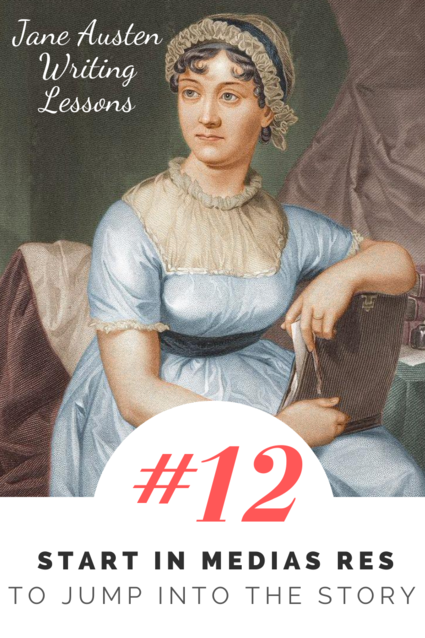
I have an unpublished novel that I wrote and revised years ago. It’s a pretty good story, but the beginning never worked. I tried starting it dozens of ways, establishing the exposition this way and that, and ultimately, I set the story aside. Now, as I look back on it, I realize that I was starting the story way too early. If I were to revise it again, I would start it much later, in medias res.
In medias res means, literally, “in the middle of things.” It’s a term originally used by Horace over 2000 years ago in his work Ars Poetica (Poetic Arts).
Basic plot structure demands that a story needs a Beginning, a Middle, and an End. But sometimes, a story does not actually need a Beginning. Or at the very least, it doesn’t need to start at the beginning.
Unlike Jane Austen’s other novels, which begin with paragraphs or chapters of exposition, establishing the characters and the world, in Pride and Prejudice, we begin in medias res. The inciting incident is that Mr. Bingley has joined the community—and this inciting incident occurs before the first page of the book. As we’ve previously discussed, inciting incidents disrupt the world of the characters, shaking them out of stasis and starting them on their journey.
In many cases, we need exposition before we can understand or appreciate how the world has been changed and its characters have been incited into action. Yet there are benefits to jumping straight into the heart of the story.

Benefits of starting a story in medias res:
-It immediately focuses the reader on the main stakes
-There is inherent excitement, energy, and movement in what comes after the inciting incident
-It avoids what could be (in certain stories) slow or unnecessary exposition
-It can create suspense to learn not just what will happen next, but also, what happened before
Chapter 1 of Pride and Prejudice
The first two paragraphs (beginning with the famed “It is a truth universally acknowledged”) are thematic, and provide commentary on society and the characters without providing true exposition. Then, starting with the third paragraph we read:
“My dear Mr. Bennet,” said his lady to him one day, “have you heard that Netherfield Park is let at last?”
Mr. Bennet replied that he had not.
“But it is,” returned she; “for Mrs. Long has just been here, and she told me all about it.”
Mr. Bennet made no answer.
“Do you want to know who has taken it?” cried his wife impatiently.
“You want to tell me, and I have no objection to hearing it.”
That was invitation enough.
We are brought immediately into the action of the novel, as Mrs. Bennet attempts to use all of her powers of persuasion to convince Mr. Bennet to call on Mr. Bingley so their daughters can be introduced to this newly-arrived, eligible bachelor.
Without need for straightforward exposition, we are introduced to things that would commonly be established in a more traditional exposition: the characters’ attributes and the importance to Mrs. Bennet of marrying her daughters.
“What is his name?”
“Bingley.”
“Is he married or single?”
“Oh! Single, my dear, to be sure! A single man of large fortune; four or five thousand a year. What a fine thing for our girls!”
“How so? how can it affect them?”
“My dear Mr. Bennet,” replied his wife, “how can you be so tiresome! You must know that I am thinking of his marrying one of them.”
“Is that his design in settling here?”
“Design! Nonsense, how can you talk so! But it is very likely that he may fall in love with one of them, and therefore you must visit him as soon as he comes.”
If dialogue is used, as it is in this case, to give hints of exposition, it must seem natural that the characters would really say these things. The effectiveness of including these details derives from the fact that Mr. Bennet is attempting to annoy his wife and feign ignorance of her matrimonial plans.
Interestingly, we don’t actually see the main character—Elizabeth—in a scene until Chapter 2. In Persuasion, each of the three sisters is given a thorough introduction by the narrator, and then we meet them and see them in action. In Pride and Prejudice, we are not given a through exposition to establish the characters; we must learn of them on the way. In the first chapter, Mr. and Mrs. Bennet only specifically reference three of their daughters, and do so only briefly:
“I will send a few lines…to assure him of my hearty consent to his marrying which ever he chuses of the girls; though I must throw in a good word for my little Lizzy.”
“I desire you will do no such thing. Lizzy is not a bit better than the others; and I am sure she is not half so handsome as Jane, nor half so good humoured as Lydia. But you are always giving her the preference.”
“They have none of them much to recommend them,” replied he; “they are all silly and ignorant like other girls; but Lizzy has something more of quickness than her sisters.”
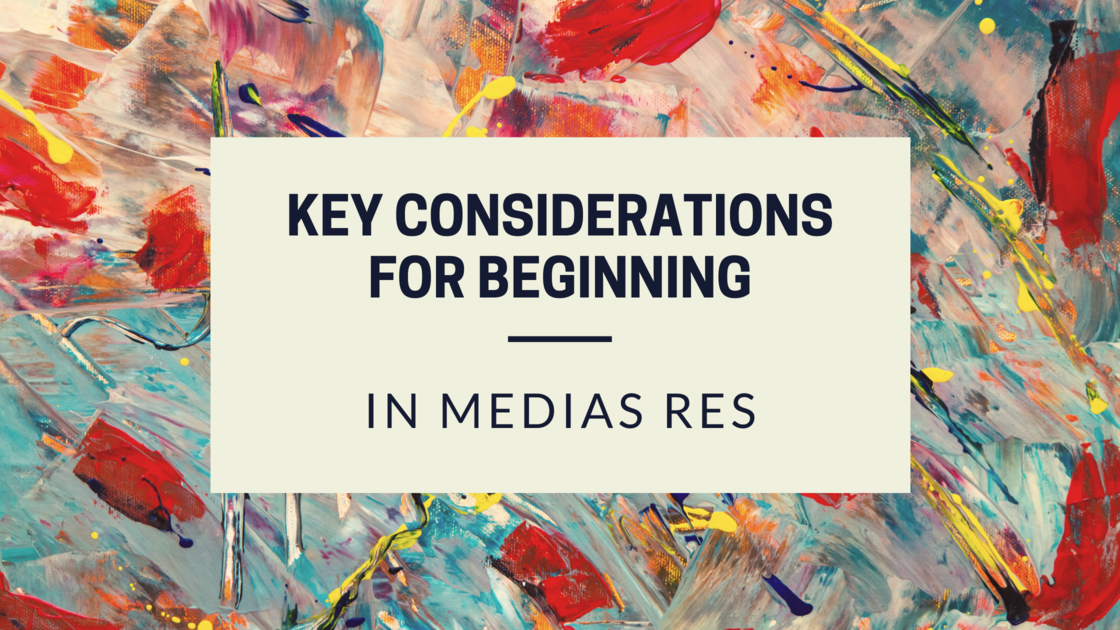
A Few Key Considerations for Beginning In Medias Res
If you’re going to start in medias res, the opening scene must be understandable without exposition or explanation.
If you’re starting in medias res, it still must be very clear how the inciting incident has changed the story world and set the characters on their journey.
And, perhaps most importantly, if you’re starting in medias res, you must avoid the temptation to infodump—to dump information, backstory, and exposition on the reader in order to provide them with what you think they surely need to know before experiencing your story.
Now, I’m going to rewrite a short portion of Chapter 1 of Pride and Prejudice, and I’m going to intentionally ruin it by adding too much backstory and exposition:
“My dear Mr. Bennet,” said his wife, Mrs. Bennet, “have you heard that Netherfield Park is let at last?” Mrs. Bennet was a woman in her early forties, who often forced conversation on her husband.
Mr. Bennet replied that he had not, though this was not strictly true.
“But it is,” returned she; “for Mrs. Long has just been here, and she told me all about it.”
Mr. Bennet made no answer. The surest way to annoy his wife—which was a source of endless entertainment for him—was to say nothing.
“Do not you want to know who has taken it?” cried his wife impatiently. He had to listen to her, he had to act, for they had five daughters, and if Mr. Bennet died, they would lose the house and be thrown out on the streets. Maybe, the new tenant, Mr. Bingley, would marry one of their daughters and save them from this fate. Jane would serve well, as she was the oldest and most handsome, though the other four daughters would also be an acceptable solution, should Mr. Bingley be drawn instead to Elizabeth, Mary, Kitty, or Lydia.
Now that was a truly intolerable passage. If you start your story in medias res, don’t do that. Do it like Jane Austen did it.

Exercise 1:
Take a novel that you’ve never read, and start reading it several chapters in. Or, take a movie you’ve never seen and start at least 15 or 20 minutes in.
As you read or watch, how do you figure out what’s going on? How do you orient yourself? How did you learn about the characters, and what can you conclude about what happened previously?
Write about your experience doing this in the comments, and what this teaches us about starting in medias res.
Exercise 2:
Some stories that begin in medias res are nonlinear—they do not take a straightforward path through time, or in other words, they do use a sequential structure.
The most common nonlinear structure is to start in the middle of the story for the prologue or an opening chapter, then to leap back in time and tell the story from start to finish.
There are many stories that use more complicated nonlinear structures, moving us back and forth from what point to another. This requires a very close attention to craft, clues embedded in the narrative that keep the reader oriented within time (unless part of the point is to disorient them), and a purposeful approach to juxtaposing one scene with another.
Choose a story that you like to tell people about something that happened in your life—an embarrassing moment, how you met a significant other, etc. Now write down the story using a nonlinear—yet still cohesive—structure.
Exercise 3:
Take a short story or a novel that you’ve written that begins with exposition. Take a few minutes and experiment with reorganizing the story so it starts in the middle of things. How late could you start the story? What details can you weave in later?

